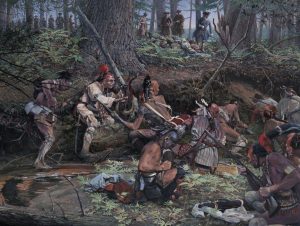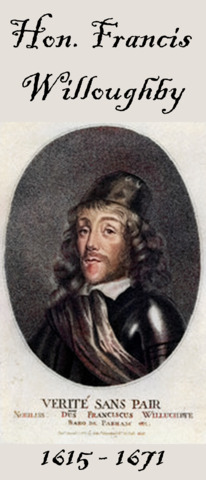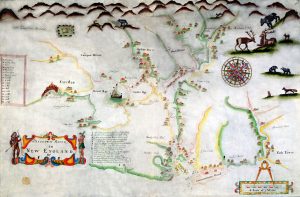SARAH BAKER NASON was Richard Nason’s first wife. Sarah was born in England in 1614, 1617 or 1620. She may have been born in London, or in the port city of Dover, in Kent in southwest England. I believe Richard Nason met and married her in Dover, New Hampshire around 1635.
Her father was Lt. John Baker, a freelance preacher, trader, and wealthy landowner. He was given to wild passions, independent beliefs on religion and aggressive behavior toward everyone. He was banished from Massachusetts Colony and returned to England in the late 1640s, where he became a member of Lord Cromwell’s Horse Guards and fought in Ireland. A staunch anti-Papist and erstwhile Puritan, he was hung for plotting a rebellion against Charles II at Tyburn in 1663. Baker’s Spring in Wells, Maine is named after him.

Sarah Baker Nason’s mother, also named Sarah, was born in England. Her last name is unknown. Sarah may have stayed with her daughter and Richard Nason after her husband returned to England; or, she may have returned to England with her husband. Some online sources asserted she was a skilled herbalist. She must have been patient, loyal, resigned, or meek to be dragged back and forth from Boston to Dover, and to various Maine points as her husband fled the Puritan authorities. Her daughter, Sarah Baker Nason, had pluck. She bore and raised nine or more children; farmed and lived off the land alongside her husband. She had few neighbors nearby, and whether English or Abenaki, they could be friendly or hostile as the competition between the French and English, and the Puritans and Nonconformists, drifted over the land like bad spirits.
Sarah sided with her husband in a fight with her father. A New Hampshire court recorded that her father, John Baker, was fined five shillings “for beating Richard Nason that he was black and blue and for throwing a fire shovel at his wife.” As happens in family gatherings, alcohol was probably behind the blow-up. Colonial settlers had plenty to drink: beer, ale, hard cider, rum, brandy, wine, and mixed drinks like flip and calibogus. Family conflict aside, Sarah must have valued her Baker name and family. Two of her sons had “Baker” in their name: Charles Baker Nason and Baker Nason. Another one of her sons was named John, which could have been for Richard Nason’s father has well as for her father. One of her daughters was named Sarah, perhaps after her mother. We do not know the year that she died; various Nason family trees suggest it was sometime between 1661-1664. She may have died in childbirth, an accident, or an illness.
In all the online Nason family histories that I have read, there is little agreement on the birth dates or chronology of Richard and Sarah Nason’s children.
Richard Nason may have been born in 1639, 1642, or the mid-1640s at Pipe Stave Landing in South Berwick, ME. He married Shuah Colcord in 1662 or 1664. She was the daughter of Edward and Ann (Warde) Colcord. Richard and Shuah had three children (Sarah Nason Sanborn, 1665-September 1, 1748); Richard Nason/Jacques Ritchot, 1667-1729; and Jonathan Nason (1670-?). Jonathan married Huldah Sanborn on October 17, 1705, and moved to Hampton Falls, NH.

Richard Nason was shot and killed by an Abenaki warrior in his doorway in October 1675 and his young son, Richard, taken to Canada as a captive and sold to a French family. Richard Nason is mentioned on page 381 in the book, New England Captives Carried to Canada Between 1677 and 1760 During the French and Indian Wars by Emma Lewis Coleman, 1925. “NASON, Richard, son of Richard, Jr., and Shuah…b.1667 in what is now South Berwick. In October 1675, after the second attack on Tozier’s house the Indians went southward to Sturgeon Creek where tradition says Richard Nason, Jr. was killed in his own doorway and his son Richard, third of the name, was carried to Canada.”Richard’s death was during a period known as King Phillip’s War and the South Berwick area was subject to raids and ambushes. Richard Nason Sr.’s home on the Salmon Falls River was not attacked, but after his son was killed, both Richard and his son, Jonathan, built garrison houses for themselves and neighbors. (Note: there is disagreement on the year of death and capture. Alterative dates are 1685 and 1689.) The young boy was brought to the Abenaki settlement at St. Francois du Lac in Quebec. He was sold to a French family as a servant, and later married the daughter of the family. Richard was baptized and given the name, Jacques Ritchot. His parents were named “Ritchot” and “Suzanne Calquet.” He died on April 8, 1729, in Yamaska, Quebec.
John Nason may have been born in 1636, 1640, or 1645 in South Berwick, Maine. He married three times: Hannah Heard, November 6, 1674; 2nd wife unknown; Bridget Weymouth on October 7, 1687. He died on October 6, 1719, in South Berwick.
Charles Baker Nason may have been born in 1636 or 1645. He had a land grant in 1669. He married Abigail Willoughby, the niece of Francis Willoughby, the Deputy Governor of Massachusetts. According to a descendant’s online account, Willoughby did not support King Charles I and favored his deposition and beheading—a similar sentiment to another Boston/Charleston resident—John Baker, Charles’ grandfather. Charles Baker Nason’s will was made in 1698 and he died that year. 
Jonathan Nason may have been born in 1638, 1642, 1644, 1645, or 1648. He married Sarah Jenkins, daughter of Reynold and Ann (Gale) Jenkins, around 1668-1670. Jonathan had a land grant in 1670. He was killed by his brother, Baker Nason, in March 1691. A Court of Oyer and Terminer did not find Baker Nason guilty of murder or another charge. Jonathan Nason’s death may have been an accident, justifiable homicide, or murder.
Benjamin Nason may have been born in 1641, 1644, 1655, or 1656 in South Berwick, Maine. He married Martha Canney (or Kenney) on June 30, 1687. Their daughter, Sarah, was captured by Indians in 1694. A ransom was paid, and she was returned to her family after a few years. After Martha Canney died, Benjamin married Sarah (Bolles) Chadbourne and then Elizabeth (Martyn)(Kennard) Furber. He died on July 17, 1714, or August 11, 1714.
Joseph Nason may have been born in 1640, 1642, 1648, 1652 or 1655. He married Mary Swain, daughter of John and Mary (Weare) Swain in 1671 in Dover, New Hampshire. He was taxed at Cochecho (New Hampshire) in 1671. Joseph and Mary moved to Nantucket, Massachusetts. They had a daughter, Charity, who was born September 17, 1682. She married Joseph Meader. Joseph Nason died in Nantucket on September 27, 1714. Some online family histories noted that he became a Quaker.
BAKER NASON is our direct ancestor. He may have been born in 1634, 1635, 1642, 1646, 1655, or 1665 in South Berwick, Maine. Baker Nason was a carpenter. He married Elizabeth Hatch (b. 1657-d. 1640 or after) in 1691 or 1692. She was the daughter of Philip and Patience (Edge) Hatch of Wells, Maine. They had eleven children: Patience (1692), Elizabeth (1694), Sarah (1696), Hephzibah (1699), Bridget (1701), Samuel (1704), John, Joseph (1708 – our direct ancestor), Lydia, Mary, and Prudence.
Baker Nason had a hot temper like his namesake and grandfather, John Baker. He killed, or caused the death of his brother, Jonathan Nason, in 1691 by hitting him with a canoe paddle. Samuel Sewall, a judge in Boston, noted the incident in his diary on 11 March 1691/2: “Capt Wincoll brought us the Jury’s verdict about Baker Nason killing his elder brother Jonathan Nason with his Oar in the Canoe in Piscataquer River: and asks advice whether to keep him there or send him to Boston Prison. Seems to have done it in’s own defence.”[ (see blog post.). Some other recorded encounters with the law included a fine of 5s to the poor for “cursing and swearing.” He was sued for detaining William Parson’s horse in 1695-6 for the nonpayment of work Baker had provided him.

In 1694, Richard Nason deeded his original land grant to only two of his sons, Benjamin and Baker. It was then bounded on the south with the land of “Widdow Lord” and on the North with the lands that were late Thomas Spencers deceased and on the west with the tide water.” (Stackpole, pg.126). It is a mystery to me why only two children received his property. My guess is that they were the only children who lived on the Pipe Stave Landing grant. Richard and his second wife, Abigail Follet, also lived with Benjamin.
On August 4, 1726, Baker Nason deeded land to the town of Kittery “for the Encouragement of the Settling of a School at the Lower End of town.” The lot was 40 feet square, and a schoolhouse had already been built on it. The property was situated on the main road to Kittery, bounded easterly by the road and on the other three sides by Nason’s land. (York Deeds, XIII. 75). I was curious enough to track the site down and go have a look. Nothing remains of the schoolhouse now. Since I started school in a one-room schoolhouse, I could imagine children on hard wooden benches listening to the schoolmaster and watching the buzz of flies and bees. I pondered what in Baker’s life prompted him to help organize a school for youngsters? He knew school would give them exposure to books, ideas outside oral tradition, and develop skills beyond preparation for practical necessities. The inventory of Richard Nason’s estate mentioned that he owned several books–an unknown luxury except for the very well-to-do.
Baker Nason died in June 1729 in Berwick, Maine. His will was probated on June 30, 1729. In his will he mentions “wife Elizabeth, three sons Samuel, John and Joseph and seven daughters Patience, Elizabeth, Sarah, Hepsebeth, Lydia, Mary and Prudence.” The only daughter not mentioned was Bridget. The fact that everyone was alive attests to a good hardy stock and a well-provisioned life.
Sarah Nason may have been born in 1643,1645, 1647, 1650, 1652 or 1654 in South Berwick, Maine. She married Henry Child (born around 1648), who was killed by Indians on September 25, 1691. Her second husband was John Hoyt, whom she married on November 10, 1695. She died before 1723 in Newington, New Hampshire.
Mary Nason may have been born in the early 1650s, 1655 or 1659 in South Berwick, Maine. She married Ephraim Trickey and later William Witham. Her date and place of death are unknown. Her married life may have been spent in New Hampshire.
Dover Nason, a son who died young, was only mentioned in one online family history as born in 1653. I’m not sure he existed.
ABIGAIL FOLLETT was Richard Nason’s second wife. She was born in England in 1625 or 1626. Abigail was the widow of Nicholas Follett. Richard married his second wife in 1664 or 1665. They lived together for over thirty years until his death in 1695-6. Abigail’s children (youngsters and teens) moved with her to Richard Nason’s house, and they were raised together with Nason’s younger children. She had two sons, Nicholas, and Philip, and one daughter, Sarah. Philip Follet was considered an adult by 1670, when he witnessed a deed. Sarah Follett was born around 1654 and married John Meader by 1680. John Meader was named co-executor of Richard Nason’s will by a codicil. Richard Nason carefully provided for Abigail Follett in his will. All the property she brought into the marriage was returned to her. Abigail’s children were also named in his will so it is clear that he had good relationships with them. Abigail died in Dover, New Hampshire around 1706.
Richard Nason was married to his first wife, Sarah Baker, for around 30 years, and the second, Abigail Follett, for roughly the same amount of time. He only had children with his first wife, but it appears that he was very fond and close to his second wife’s children. At the time of his death, he and his wife, Abigail, were living with his son, Benjamin, at Pipe Stave Landing. Two or three of his nine children were dead: Sarah? Richard, killed by Indians in 1675 or 1685-91, and Jonathan, killed by his brother, Baker in 1691/2. His son Joseph had left Maine for Nantucket. His surviving sons–John, Benjamin, Baker, and Charles lived in Maine or New Hampshire. He had scads of grandchildren and great grandchildren.

The Nasons were off to a strong start in the New World, spreading north to Canada, and south to other parts of the colonies. Our particular branch, descended from Baker Nason, eventually traveled from Berwick, Maine to Kingstown, Rhode Island, Otego, New York, Girard, Pennsylvania, Hammond, Indiana, Garfield, Colorado, back to Hammond, Indiana, and from there to Elizabeth, New Jersey. We are now found throughout the United States.

Hello,
I want to let you know, that I enjoyed your article above and that it was quite helpful, in answering a few of my questions and confirming my thoughts about some others. I would like to ask you a question, if it’s alright with you. I came across a profile for Jacques Ritchot (Richard Nason) on Wikitree, in which the profile manager stated that Jacque’s parent’s identities are ‘uncertain’. In light of many sources I have viewed, including your article above (all of which confirm Jacques Ritchot’s parentage), how can the profile manager that I just mentioned, cast doubt upon the fact that Jacque’s parents are Richard Nason and Shua Colcord? Is he somehow correct, and are there other valid sources which disprove that Jacque’s parents were Richard Nason and Shua Colcord? Learning the correct identity of Jacques’s parents is important to me, as he is an ancestor of mine, and I have spent a considerable amount of time in adding his branch of my family tree. If you would be able to assist me in answering these questions, I would greatly appreciate it. Thank you very much for your time.
Regards,
Christopher-Jude Wekelo
Dear Christopher-Jude,
Thank you for writing to me. 99% of the accounts I have read about Richard Nason, Jr. has him killed by Indians during a raid and his 8-year-old son, Richard, taken to Canada as a captive. His parents’ names are accepted by those 99% as Richard and Sarah or Shuah Colcord. I accept their accounts as “generally accepted” history. If it is not the exact truth, it is very close. That is the best we can do at this time, 330 years from the event. I can send you some material I received from our “cousin,” Jack Nason, which I think is the best account of this story. If you are willing to send me your email I can send it to you. My email is – blueduck11944@gmail.com. A Canadian descendant of Richard Nason, Dominique Ritchot, maintains a blog on the family. You might want to contact her, too. http://gen-familleritchot.blogspot.com/ and http://www.genealogywise.com/profile/DominiqueRitchot
[…] of Richard Nason’s sons were dead by the time he made his will in 1695. His son, Richard, was killed by an Abenaki warrior in 1675 or 1685 (date based on his wife remarrying in 1687) although some […]
This is my complete ancestry
Ty
Please send your complete ancestry. Do you find the author, Kenneth ROBERTS In your lineage? I know he traces his ancestry to the original Richard Nason
Richard,
Kenneth Roberts is not in my lineage. My ancestor is Baker Nason, a younger son of Richard Nason. I believe Roberts is descended from one of the other sons.